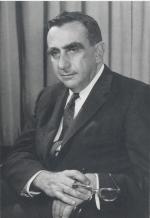
Figure 268652: Teller blog image
Edward Teller
Courtesy of Lawrence Livermore National Laboratory (LLNL)
To celebrate 70 years of advancing scientific knowledge, OSTI is featuring some of the leading scientists and works particularly relevant to the formation of DOE, OSTI, and their predecessor organizations and is highlighting Nobel laureates and other important research figures in DOE's history. Their accomplishments were key to the evolution of the Department of Energy, and OSTI's collections include many of their publications.
Born in 1908 in Budapest, Hungary, Edward Teller moved to Germany in 1926, earned an undergraduate degree in Chemical Engineering at University of Karlsruhe, and in 1930 was awarded a Ph.D. in physics from the University of Leipzig. His doctoral dissertation dealt with one of the first accurate quantum mechanical treatments of the hydrogen molecular ion. He moved to the United States in 1935 and was a physics professor at George Washington University (GWU) until 1941, the same year he became a U.S. citizen.
Teller's career (link is external) can be divided roughly into two overlapping phases. The first, from 1928 to about 1952, was largely devoted to scientific research and university life. In the second phase, which coincided with the discovery of fission in 1939, he focused on applying physics to defense and, later, on cofounding the Lawrence Livermore National Laboratory.
At GWU, Teller predicted the Jahn-Teller Effect (1937), which distorts molecules in certain situations; this effect is especially significant in the chemical reactions of metals, and particularly in the coloration of certain metallic dyes. Teller and Hermann Arthur Jahn analyzed it as a piece of purely mathematical physics.
Teller went to work on the Manhattan Project in 1943 at Los Alamos National Laboratory and contributed to several projects such as determining the critical amounts of different uranium compounds. During this time, he made a serious push to develop the first fusion-based weapons, but these were deferred until after World War II. After President Truman announced a crash program to develop a hydrogen bomb in 1949, Teller concentrated on the project and contributed to the decision to make the thermonuclear reaction a major part of the U.S. defense program.
In 1952, based on his belief that research on thermonuclear devices should proceed rapidly, Teller collaborated with Ernest O. Lawrence to found a new weapons research laboratory in Livermore, California. Today, the mission of Lawrence Livermore National Laboratory (link is external) has expanded from advancing nuclear weapons science to encompass a wide variety of energy, national security, and technological research areas.
Teller and others recognized that nuclear power (link is external) offered a potentially clean and inexpensive alternative to other sources of energy. He foresaw the developing world would significantly increase its energy consumption as its standard of living rose and saw nuclear power as a key option for the long term. Teller also addressed the potential benefits and advantages of fusion energy.
Teller was a fellow of the American Academy of Arts and Sciences, the American Association for the Advancement of Science, and the American Nuclear Society. Among the other honors he received were the Albert Einstein Award, the Enrico Fermi Award and the National Medal of Science. Teller was awarded the Presidential Medal of Freedom by President George W. Bush less than two months before his death in Stanford, California, on September 9, 2003.
Brian O'Donnell is Program Analyst/Communications Specialist in the DOE Office of Scientific and Technical Information.